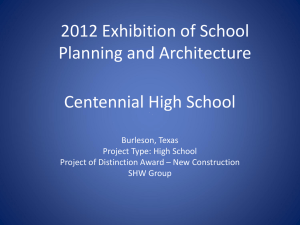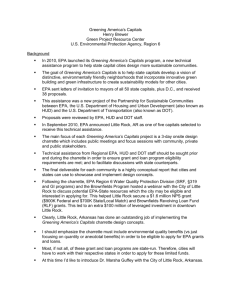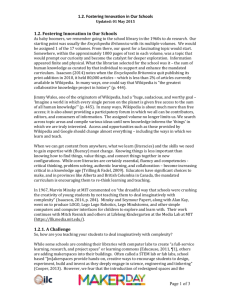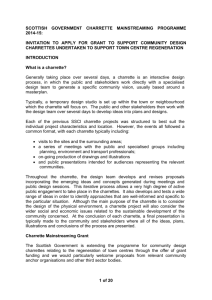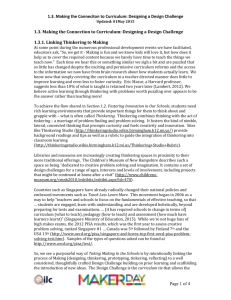Open - The Scottish Government
advertisement
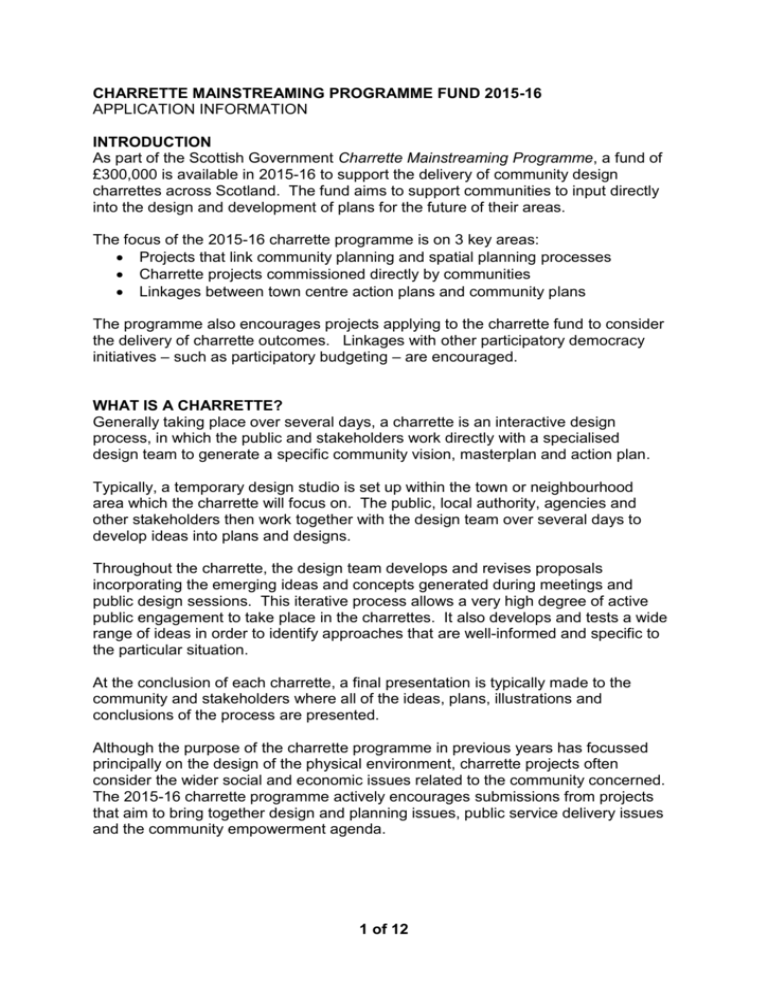
CHARRETTE MAINSTREAMING PROGRAMME FUND 2015-16 APPLICATION INFORMATION INTRODUCTION As part of the Scottish Government Charrette Mainstreaming Programme, a fund of £300,000 is available in 2015-16 to support the delivery of community design charrettes across Scotland. The fund aims to support communities to input directly into the design and development of plans for the future of their areas. The focus of the 2015-16 charrette programme is on 3 key areas: Projects that link community planning and spatial planning processes Charrette projects commissioned directly by communities Linkages between town centre action plans and community plans The programme also encourages projects applying to the charrette fund to consider the delivery of charrette outcomes. Linkages with other participatory democracy initiatives – such as participatory budgeting – are encouraged. WHAT IS A CHARRETTE? Generally taking place over several days, a charrette is an interactive design process, in which the public and stakeholders work directly with a specialised design team to generate a specific community vision, masterplan and action plan. Typically, a temporary design studio is set up within the town or neighbourhood area which the charrette will focus on. The public, local authority, agencies and other stakeholders then work together with the design team over several days to develop ideas into plans and designs. Throughout the charrette, the design team develops and revises proposals incorporating the emerging ideas and concepts generated during meetings and public design sessions. This iterative process allows a very high degree of active public engagement to take place in the charrettes. It also develops and tests a wide range of ideas in order to identify approaches that are well-informed and specific to the particular situation. At the conclusion of each charrette, a final presentation is typically made to the community and stakeholders where all of the ideas, plans, illustrations and conclusions of the process are presented. Although the purpose of the charrette programme in previous years has focussed principally on the design of the physical environment, charrette projects often consider the wider social and economic issues related to the community concerned. The 2015-16 charrette programme actively encourages submissions from projects that aim to bring together design and planning issues, public service delivery issues and the community empowerment agenda. 1 of 12 WHO CAN APPLY? The fund is open to community groups, third sector organisations, local authorities and anyone involved with the design, planning or delivery of regeneration projects or new development. Proposals from relevant community anchor organisations and other third sector bodies are particularly welcome. Community groups applying directly for funding must be properly constituted bodies and able to receive funds. We are interested in funding charrettes that will bring together all the key players required to implement positive change in a place. Therefore, where a community group is the lead applicant, evidence of the support of the local authority must be provided. Projects applying for funding should be able to set out wide-ranging, proactive commitment to the charrette process from relevant organisations. Charrettes that focus on town centres, development planning, and community planning are particularly encouraged. BUDGET AND FUNDING LEVELS The fund operates on the principle of match funding, with a maximum anticipated grant award of 50% towards the cost of a charrette project. The maximum grant awarded to any one project is expected to be in the order of £15,000-£20,000. Grant awarded will be exclusive of any requirement to pay VAT which will be the responsibility of the project sponsor. The level of grant support may be increased for charrettes where the project sponsor is a community group. In such instances the project sponsor should provide details on what proportion of funding is sought, why an increased level of funding is required, and a commitment to continue to work to deliver the outcomes of the process following the conclusion of the charrette. REQUIREMENTS Projects submitting to the 2015-16 charrette fund should be able to demonstrate that they will be an effective method of supporting one or more of the following criteria: Supporting communities to achieve their own goals through taking independent action leading to positive physical change Developing effective linkages between community planning and spatial planning processes The development and effective implementation of town centre action plans The development and effective implementation of local development plan processes Charrette projects are expected to promote an approach that seeks to harness the existing and potential assets of a place in order to develop integrated plans for future change, where relevant, the delivery of public services. Proposals developed through charrettes should be informed by relevant Scottish Government policies and principles, such as Scottish Planning Policy, Designing Streets, Creating Places, and the Town Centre First Principle. 2 of 12 PROPOSAL CONTENT Proposals should support the objectives of the Scottish Government for sustainable development. Promoters are requested to outline the proposal in a short and focussed written document of not more than 6 - 8 pages based on the following themes. 1. Project - Vision and Aims Proposals should demonstrate how they contribute to a vision for high quality sustainable development, providing detail in a clear and accessible format on the issues listed below. Relevant plans and drawings may be provided to illustrate these issues. The nature of the proposal, including the current stage of any relevant proposals or processes. The location and scope of the project. Key issues that the charrette will be expected to deal with: masterplanning, landscape issues, service delivery, flooding, transport etc. How the proposal is aligned with the aims of relevant Scottish Government policies and principles for development, regeneration and community empowerment. An outline of any wider benefits to the community covering potential economic, health, environmental and social issues. Any other relevant issues. Proposals that focus on any issues that are relevant to the place will be considered, however projects that focus on town centres, development planning and community planning are encouraged. 2. Process and Engagement Proposals should demonstrate the buy-in of key stakeholders or a strategy for encouraging participation of such groups in the charrette. Proposals that are made in collaboration between a number of interested parties, especially local community groups, are particularly encouraged. Proposals that could lead to initiatives that generate income for a community are also especially welcome. Proposals are expected to include: A indicative programme, providing details on the expected timing and duration of the charrette and delivery of the charrette outputs – charrettes are expected to be completed by 31 March 2016. Confirmation local authority support for the charrette proposal. Local authorities support should be across all relevant departments and services. A brief explanation of key personnel who will act as client for the project and their relationship to the structure of the organisation(s) commissioning the charrette 3 of 12 3. An indicative list of groups or individuals who are, or are likely to be involved in the charrette process. This should include wherever possible, representatives from the community planning partnership. Details on the process being used to select and appoint the charrette consultant design team, including proposed timescales for the appointment process Details of how the project sponsor expects to provide practical assistance in the organisation of the charrette. This may include details on venues, publicity and community organisation or council officer input. Suitability, Outputs and Implementation The interrogative, design-led approach of charrette working can assist many types of project at a variety of stages. A main aim of the charrette mainstreaming programme is to promote the use of this methodology through projects that will benefit the most. Proposals should therefore be able to demonstrate the suitability of charrette working within their general approach to the regeneration of the town centre and a commitment to a design-led approach within the wider process. It is important that the charrette provides the opportunity to improve the development and quality of the overall regeneration process and is not viewed simply as a consultation process. How charrette outputs are taken forward after the charrette to influence the quality of the wider regeneration project is of critical importance. Proposals are expected to include: A statement on why a charrette is viewed as the best way to progress the project. Information on how the outputs of the charrette will be taken forward after the charrette event programme is completed including: o A programme setting out a delivery development period within the postcharrette period. o An indication of the potential routes identified to deliver charrette outcomes including whether these relate to short, medium or long term processes. i.e. - inclusion within the Local Development plan process (medium/ long term), link to participatory budgeting processes for short term projects. o Support for community capacity building following the charrette o Identification of relevant local authority of Scottish Government or other funding/ support initiatives o Any investment or capital grants available for short/ medium term projects A FOCUS ON DELIVERY A key focus of the 2015-16 charrette programme is on supporting projects that have a well-considered approach to delivering the outcomes of the charrette. Proposals submitted for funding should contain details of how it is proposed that charrette outcomes will be taken forward. The charrette programme should include a delivery development period within the post-charrette period. 4 of 12 Charrettes generally cover a diverse range of issues and generate a range of outputs. Although it is not possible to anticipate what these output will be in advance of the charrette, it is vital that some consideration is given to how delivery will be supported. This may involve the setting up of a delivery steering group, further postcharrette support from the design team or other consultants or the advance preparation a range of potential of funding and resourcing opportunities. This can help to prioritise the delivery of any action plan objectives. It is also important that charrettes focus on developing a plan that is practical, and implementable. The raising of community expectations with proposals that are unlikely to be delivered can be damaging and the charrette process should maintain a balance between striving for ambitious proposals and maintaining a focus on the resources available to deliver the outputs. In order to continue momentum after a charrette event, it can be useful to prioritise short-term projects that will allow communities to see real change within their environment and, where possible, to be directly involved in the delivery of change. Delivery of charrette outcomes are expected to include short, medium and long term proposals. Spatial planning and community planning may typically expect to relate to medium and long term objectives. Charrettes often generate significant community energy and it is important that this capacity is harnessed. Identifying short term projects that, wherever possible, include community involvement can be an important method of translating the energy within communities into positive change. Consideration should be given to how the delivery of short term, community based projects are supported in the post-charrette period. Scottish Government will highlight to selected projects what opportunities for support and funding are available for the implementation of charrette outcomes. A proportion of grant support may be allocated to the development of action/ implementation plans following the conclusion of the charrette. All elements of the project supported by grant awards through the charrette mainstreaming programme should be complete and grant expended by 31 March 2016. HOW TO SUBMIT Proposals should be submitted in an electronic format by email. Hard copies are not required. Proposals should not be more than 8 pages at A4 format. In addition, a 2page summary document (as Annex C), should be completed and attached to the proposal. We would also encourage the use of Annex C to make any informal enquiries. An informal submission may also contain any other appropriate brief documentation which helps support the proposal. We will aim to make decisions on proposals within a 4 week time period following acceptance of any submissions. Project sponsors will be informed if their proposal will not be assessed within this timescale. Projects that require quicker turnaround of a decision should make this clear in their submission. 5 of 12 Proposals should be submitted to: Jamie Combe Architecture and Place Planning and Architecture Division The Scottish Government Area 2-H South Victoria Quay Edinburgh EH6 6QQ T: 0131 244 7461 E: Jamie.Combe@scotland.gsi.gov.uk Once the full proposal has been submitted, no further information will be accepted unless requested by the Scottish Government.Further background on the use of charrettes and the SSCI Charrette Mainstreaming programme is also provided at Annex A. There is no closing date for submissions and any projects will be assessed on a first come first served basis. This may be reviewed at any point and a deadline subsequently set depending on demand on the fund. Any projects making informal enquiries will be informed directly if a deadline is subsequently set. The project sponsor will be responsible for selecting and appointing a specialist design team to devise and deliver the charrette. The procurement process for a design team should be conducted within the normal practice and processes of the project proposer. Scottish Government procurement rules will not apply, but the project proposer should be able to demonstrate that the process delivers best value for money and quality of service. Advice on the process of selection of a suitable design team and development of the pre-charrette and charrette programme of events is attached as Annex B. The Scottish Government should be kept informed of progress in these processes. Further advice and support for individual projects will also be available. Project proposers will be required to provide all necessary base information for the charrette and make all necessary preparatory arrangements: the cost of providing these will not be grant-fundable. The exact requirements of individual charrettes will vary and details will be required to be agreed between the design teams, project teams and the Scottish Government in advance of award of grant. It is a requirement of grant funding that charrettes are intensive, iterative multi-day events: involving cycles of plan development, presentation, and refinement; and are design-led with predominantly graphic outputs. Charrettes should normally consist of a series of events taking place over consecutive days. There may be circumstances where there are good reasons to break the project into more than one period of active engagement and collaborative design and the format and timescale proposed should be devised to fit individual circumstances. 6 of 12 Conditions for the award of grant to successful proposals Projects judged to address the above issues well and which have the ability to assist the mainstreaming of charrette style working throughout Scotland will be eligible for a grant towards the cost of the project. Grant cannot be paid to cover any VAT applicable to the project. The maximum grant awarded to any one project is expected to be in the order of £15,000-£20,000. Grant will only be awarded where the proposal is in line with the criteria set out in this document. The Scottish Government’s standard conditions for the offer of grant will apply. Grant funding will be conditional until appropriate details of the charrette programme and the procurement process are provided along with confirmation of completion of the process of appointment of the design team. After discussion with the project sponsor, an end date for the provision of this information will be set for each project, after which funding will be withdrawn if sufficient information has not been provided. Grant payments will be made in line with an agreed payment schedule. Grant will be paid in arrears following completion of agreed milestones and the full grant awarded to any project is required to be paid out by 31 March 2016.All agreed deliverables and conditions for the award of grant will be required to be met before grant is paid. Scottish Government officials may require to be involved as observers at projects awarded grant funding. SCOTTISH GOVERNMENT POST-CHARRETTE INVOLVEMENT It is expected that following the conclusion of the charrette, project teams will support the promotion of the process and lessons learned. This may involve providing feedback into a charrette summary report which will help to inform future charrette working in Scotland. Sensitive or commercially confidential information will not be published. Projects selected for grant assistance may be supported throughout the charrette process by the Scottish Government. Formal support for the project will be limited to the charrette process and it is not anticipated that Scottish Government support through the charrette programme will continue after the obligations of the grant have been fulfilled. However, other Scottish Government programmes or initiatives may continue to support the project in the post-charrette period if appropriate. Grant support through the charrette programme will not automatically have an influence on support from other parts of Scottish Government. Further Information For further information on the charrette mainstreaming programme please contact Jamie Combe at the address provided above. 7 of 12 ANNEX A SUPPLEMENTARY INFORMATION Why use a charrette? Charrette style working is an innovative and effective way of delivering quality and efficiency. It can provide a range of benefits that are central to planning sustainable communities: Vision A crucial part of the charrette approach is that throughout the process, all contributors, regardless of their particular interest, have the opportunity to contribute towards the ultimate objective: the creation of vibrant and successful communities. This collaborative approach pulls together disciplines and practices that are all too often focused on individual issues and allowed them to maximise their effectiveness by channelling all participants towards an over-arching vision. Engagement An inspirational and energising process, charrette working allows anyone to contribute to an evolving process, harnessing vital local knowledge and empowering communities to shape their future environments. Supported by specialist designers, local contributors are able to assist in the production of proposals that reach beyond what might normally have been achievable through traditional development processes. The continual presentation and testing of ideas allows a layering of understanding and knowledge to be established, refining the proposals in a concentrated timeframe so that potential conflicts are identified and positive design opportunities are maximised. Speed and Outputs One of the principal benefits of the charrette approach is its ability to blend contributions from a wide range of interest all into a meaningful form: plans, visualisations and sketches that are easily understood and form a consistent vision. This is achieved by the design-led and highly visual approach that effective charrette working requires. Charrette working not only provides benefits in terms of input and quality, but it also has the potential to greatly increase the speed of the planning and design process. It front-loads input and it involves a concentrated period of working when contributions have the ability to make a positive impact and shape emerging proposals. Despite the intense nature of the charrette itself, the approach can be much more efficient than a conventional model on account of the time saved later in the process, when analysis is often more reactive and can have less positive influence. 8 of 12 ANNEX B THE DEVELOPMENT OF THE CHARRETTE PROGRAMME AND SELECTION OF DESIGN TEAMS The term charrette is becoming more widely used and applied to a range of varying projects. The Scottish Government Charrette Mainstreaming programme is focused on promoting charrette projects which fit within the description of charrettes outlined in the main body of this document. In the 2015-16 programme, it is the project sponsor that selects and appoints the design team for the project. The Scottish Government’s experience of the previous years of the programme has indicated that key factors for the success of the project may include: establishment of a clear set of objectives and required outputs by the project proposer at an early stage in the development of the proposal; adoption of a project management process by the project proposer which ensures adherence by the design team to the agreed objectives and outputs throughout the pre-charrette, charrette and post-charrette phases of the project; development of a realistic programme of pre-charrette and charrette events which can maximise public and stakeholder engagement; allocation of sufficient resources for the design team and staff of the project proposer to engage with the community and stakeholders in the pre-charrette period to develop interest and maximise attendance at the charrette event and maximise the extent to which background information can be made available for the start of the charrette event; the selection of a design team that can provide the range of experience and resources to work within the programme agreed between the project promoter and the Scottish Government and deliver the agreed outputs required. THE DEVELOPMENT OF PRE-CHARRETTE PROGRAMMES As long a period as possible should be allowed for the pre-charrette engagement with relevant communities. A range of processes and activities have been used successfully in the past to reach as many local people as possible. These include the following: use of social media: Twitter and dedicated Facebook page webpage with blogs and updates as project proceeds a physical exhibition explaining what the charrette is going to do use of a large scale aerial photograph of the community to discuss issues and make video recording of ‘incidental’ interviews with local people which can be used at charrette event 9 of 12 ANNEX B news stories about the charrette in local newspapers/local radio street banners at key public locations posters/flyers at local shops/community buildings invitations/leaflets to all households questionnaires to all households: which when returned/collected can be used as part of a public exhibition at the charrette itself publish pre-charrette local newssheet work with local primary and secondary school teachers to make the charrette project part of pupil studies for some classes. pre-charrette workshops to engage community groups and umbrella organisations formal launch event with ‘walk-about’ with local politicians/celebrities THE DEVELOPMENT OF CHARRETTE PROGRAMMES The experience of the Scottish Government to date has been that for a charrette to be a successful event it should have a minimum duration of around 3-4 days of active design working within the community. The specific days and times for the charrette events should be chosen to suit the likely availability of the people the project sponsor wants to prioritise engagement with. Where a design team’s studio is accessible to the public, this can bring benefits in helping develop wider understanding of the design process and how the charrette project fits into it. THE SELECTION OF DESIGN TEAMS The experience of the Scottish Government to date has been that the skills required in the design team appointed are not simply those required for carrying out a traditional public consultation process or those required for creating masterplans. The charrette process requires the ability to integrate the skills required for facilitation of workshops involving engagement with communities with those of design and masterplanning. Design teams appointed for charrette projects to date have often been made up of several different consultancy practices that can jointly provide the range of skills and training required to deliver a charrette project which provides a high quality service throughout. A thorough understanding of Community Planning processes and the community empowerment agenda are expected to be included in design team skill sets. The ability to quickly produce easily understandable drawings and graphics is an important skill for design teams. 10 of 12 ANNEX C SCOTTISH GOVERNMENT TOWN CENTRE CHARRETTE MAINSTREAMING PROGRAMME 2015-16: SUMMARY APPLICATION FOR PROJECT GRANT Project name/location: Proposing organisation: Other collaborating organisations: Main purpose of charrette project: Grant applied for and %of total charrette cost: Source of match funding: £ % Position in organisation Contact e-mail & phone Person making application: Additional contact: Contact in local authority: Name of design team appointed, or process for its appointment: Approximate date of charrette events: Key issues charrette will deal with: Key charrette outputs: Any wider benefits to community? Additional notes 11 of 12 ANNEX C Summary of proposal: 12 of 12
